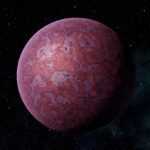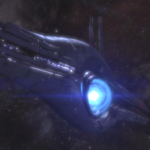System Specs:
- Stellar Mass: 1.00 Sol Masses
- Stellar Class: G
- Luminosity: N/A Sol
- Planets: 3
- Moons: 0
- Asteroid Belts: 0
- Asteroids: 0
- Objects: 1

Fortis is a gateway system. Two of its three worlds are rated rich in resources while the last one still has a good rating.
–
Planets Directory:
- Vir
- Pietas
- Aequitas
- Mass Relay
–
Vir:

- Orbital Distance: 0.6 AU
- Orbital Period: 0.5 Earth-years
- Keplerian Ratio: 0.864
- Radius: 8,162 km
- Day Length: 44.4 Earth-hours
- Atmospheric Pressure: 106.22 atm
- Surface Temp: 778 °C
- Surface Gravity: 2.1 g
- Mass: 3.414 Earth-masses
A pressure-cooker planet with a thick, nitrogen-heavy atmosphere, Vir is largely ignored by the galactic community. Probes have revealed a crust of nickel and scorched carbon, both of which can be found in abundance elsewhere, at far lesser temperatures.
–
Pietas:

- Orbital Distance: 1.8 AU
- Orbital Period: 2.4 Earth-years
- Keplerian Ratio: 1.013
- Radius: 5,430 km
- Day Length: 26.5 Earth-hours
- Atmospheric Pressure: 1.26 atm
- Surface Temp: 21 °C
- Surface Gravity: 0.7 g
- Mass: 0.504 Earth-masses
Though Pietas has a combination of features that make terraforming a possibility, the rights to the planet have been tied up in Citadel Council courts for the past eight years. The running joke is that by the time the Council finally gives the go-ahead to colonize the planet, Pietas will have evolved life of its own. Home to comfortable temperatures and a mild atmosphere of mostly nitrogen and argon, Pietas could be habitable with the addition of oxygen-producing cyanobacteria. Its crust is high in silicates and carbon, allowing for easy fabrication of construction materials.
Smugglers, pirates, and other unregistered starships sometimes touch down on Pietas to lay low or make repairs. Civilian travel is not advised.
–
Aequitas:

- Orbital Distance: 4.0 AU
- Orbital Period: 8.0 Earth-years
- Keplerian Ratio: 1
- Radius: 7,437 km
- Day Length: 51.6 Earth-hours
- Atmospheric Pressure: 0.49 atm
- Surface Temp: −85 °C
- Surface Gravity: 1.6 g
- Mass: 2.159 Earth-masses
Home to the famous Iron Canyons, Aequitas has reddish iron oxide dust (hematite) covering much of its surface, and significant blue cobalt deposits that freckle the terrain. Turian explorers have discovered hot springs in the polar ice caps, heated by magma in the planet’s crust. In a strange combination of science and hucksterism, a small facility exports water from these springs, which is bottled and sold as having medicinal properties. The funds are then used to maintain a research station, which has discovered some fossil evidence that Aequitas once harbored microscopic life based on deoxyribonucleic acids in these springs.
–
–
video





